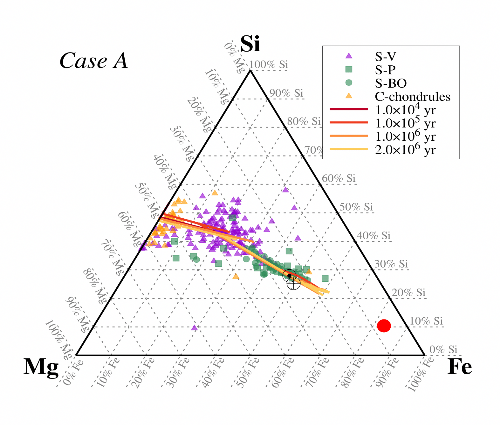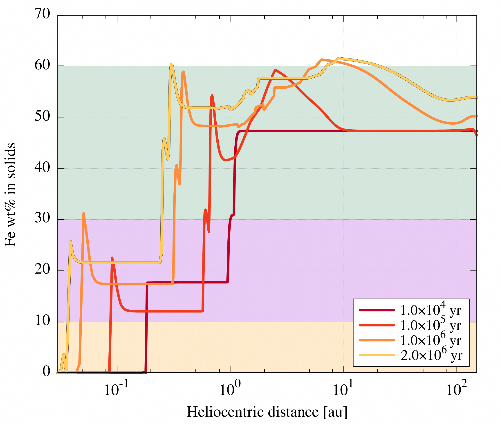- 1Aix Marseille Univ, Institut Origines, CNRS, CNES, LAM, Marseille, France (artem.aguichine@lam.fr)
- 2Aix Marseille Univ, Institut Origines, CNRS, CNES, LAM, Marseille, France
- 3CEREGE, Aix-Marseille Université, Institut Origines, Aix-en-Provence, France
In our solar system, meteoritical matter exhibits a variety in bulk compositions that is representative of the processing history of refractory matter in the protosolar nebula (PSN). This history is usually investigated via a thermodynamic approach, where refractory grains condense out from a hot cloud. However, in the innermost regions of the PSN the migration timescale of grains can exceed the evaporation timescale of refractory species.
We investigate the role played by rocklines (condensation/sublimation lines of refractory materials) in the innermost regions of the PSN to compute the composition of drifting and evaporating grains. To do so, we compute the evolution of the PSN using a 1D viscous accretion disk model [1]. The disk is initially filled with dust that is a mixture of several refractory species of protosolar composition. This dust exists in the form of refractory grains and their vapors. The radial transport of grains is computed by solving an advection-diffusion equation, and phase transitions are accounted for by computing sublimation and condensation rates for each species. We then compare the composition of the PSN computed by our model with the composition of meteoritical bodies collected on Earth.
We find that the compositional gradient in the PSN that is created by rocklines, shown in Figures 1 and 2, matches the composition of cosmic spherules, chondrules, and chondrites. Moreover, our model shows that solid matter is concentrated in the vicinity of these sublimation/condensation fronts. Although our model only focuses on the most abundant refractory species (olivine, represented in our model by its end members forsterite and fayalite; enstatite and ferrosilite pyroxenes; kamacite and taenite metal; and iron sulfide), it suggests that rocklines heavily processed refractory matter in the PSN, which has important consequences for the composition of small and large bodies in the innermost regions of the solar system. The local increase of the iron abundance close to rocklines of iron alloys could have contributed to the high Fe-content in Mercury.

Figure 1. Composition profiles of the PSN in a Mg-Fe-Si ternary diagram (expressed in mass fraction) at different times, with composition of glass cosmic spherules (S–V type), barred olivine spherules (S-BO type), porphyritic spherules (S-P type) and C-chondrules. Protosolar and Earth’s compositions are represented by Sun’s and Earth’s symbols, respectively, and Mercury’s composition is represented by a red circle.

Figure 2. Same as Figure 1, but here the Fe wt% is represented as a function of heliocentric distance. Color boxes correspond to typical compositions of chondrules (0%–10%), glass cosmic spherules (10%–30%), and porphyritic and barred olivine cosmic spherules (30%–60%).
[1] Aguichine, A., Mousis, O., Devouard, B., and Ronnet, T. 2020, ApJ, 901, 97.
How to cite: Aguichine, A., Mousis, O., and Devouard, B.: Processing of refractory species in the vicinity of rocklines, Europlanet Science Congress 2022, Granada, Spain, 18–23 Sep 2022, EPSC2022-358, https://doi.org/10.5194/epsc2022-358, 2022.

